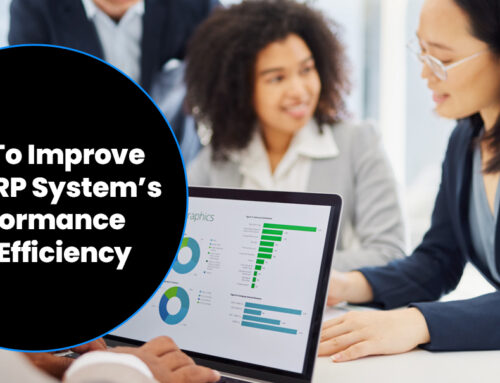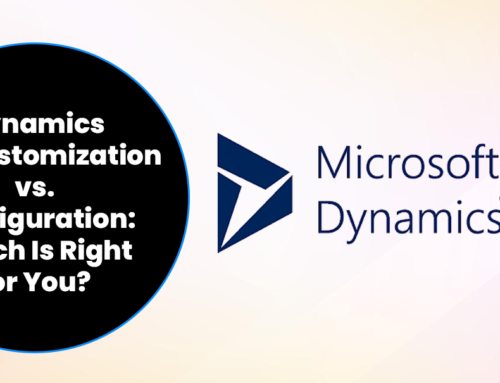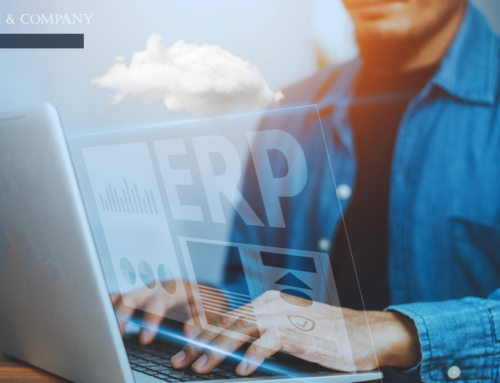
Achieving the ideal solution of implementing a single ERP product throughout the entire organization while maintaining the efficiency and flexibility of individual business units is undoubtedly challenging. Many global companies struggle with this goal. A new trend is emerging within the realm of enterprise resource planning (ERP) – the adoption of a two-tier ERP model. The two-tier ERP approach is a technological solution implemented by large enterprises with multiple locations or subsidiaries to cater to their unique business requirements.
This strategy entails utilizing two systems: a Tier 1 ERP at the headquarters, which offers high customization capabilities and functionality for managing a global organization, and a Tier 2 software for smaller business units, which is less resource intensive. The Tier 1 ERP system is specifically designed for enterprises with a global presence. However, installing, maintaining, and upgrading these systems is exceedingly expensive. The development process to meet the diverse requirements of businesses is time-consuming, leading to prolonged implementation periods.
Typically, the responsibility of managing this software lies with the IT teams within the companies. Examples of Tier 1 ERP systems include SAP, Syspro, Microsoft Dynamics, and Oracle. On the other hand, Tier 2 ERP software is well-suited for midsize and small businesses. Compared to Tier 1 software, Tier 2 ERP systems are generally more affordable and easier to implement. For example, include Epicor, NetSuite, Plex, Sage, and Syspro.
Single ERP Instance Implementation
Traditionally, employing a Single ERP system was the norm for all organizations, and it was the primary choice for most enterprises until recently. This approach offers several proven benefits, including centralized IT management, uniform application, and data usage across the organization for easier training and support, and reduced complexity in terms of skills, vendors, and integration tasks.
The streamlined nature of the Single ERP approach continues to hold value today, as it was once considered the epitome of efficiency. However, this monolithic approach to ERP systems comes with its disadvantages. Adopting a one-size-fits-all strategy risks compromising functionality for certain parts of the business while burdening others, especially smaller regional offices or acquired companies, with unnecessary and costly features.
Implementing an enterprise-wide Single ERP system involves significant investments in terms of time, money, and resources. Considerations must be made for implementation costs, license fees, and ongoing maintenance support fees associated with large tier-one ERP software, some of which persist indefinitely.
Furthermore, configuring these systems can be highly complex, particularly when different business units operate in disparate environments. A generalized ERP software may lack the necessary flexibility to cater to the diverse business requirements of various teams, thus imposing industry-standard approaches that may not align with unique business practices. In the worst case, this lack of flexibility can harm competitiveness by disregarding distinctive business processes.
Nevertheless, customizing the software for individual business units undermines the inherent simplicity that the Single ERP instance approach was originally designed to offer. So does that mean a two-tier ERP Instance strategy is better than a Single ERP instance strategy? Before concluding, we must clarify some myths around Single ERP instances and 2-tier ERP architecture.
Myth 1: Seamless Out-Of-Box Integration
The concept of “seamless integration” is often used as a marketing term and does not accurately reflect the technical reality of out-of-the-box (OOTB) integrations between multiple ERP systems. Achieving a seamless integration between different ERP solutions, each with its own proprietary data models necessitates that each ERP solution perceives itself as the primary source of truth. This requires synchronization across various aspects such as configuration, workflow, security settings, as well as transactions originating in the source ERP system and confirmed/completed in the target ERP system.
Deep integration facilitates the synchronization and transfer of data across multiple layers, playing a vital role in establishing a comprehensive enterprise ERP solution. On the other hand, point integration only offers basic functionality to send and receive business transaction data. Point integration typically lacks comprehensive support across the entire enterprise level, necessitating additional manual efforts to maintain synchronization of configuration, workflow, and security data between multiple ERP systems.
Given the significant expenses associated with developing deep integrations between distinct ERP systems, most implementations choose the manual approach to maintain the synchronization of configurations. However, this tactical decision can have implications for business users going forward.
Myth 2: Data Integration is Easier with a Single ERP Vendor
The prevailing misconception in the ongoing debate between best-of-breed and single ERP vendors is that integration will be smoother and simpler if it comes from a single vendor. Conversely, solutions from external vendors are believed to face challenges in working effectively with other software in the existing environment, leading to integration issues that surpass the allocated time and budget.
While acknowledging the advantages of achieving a single ERP environment, it is unlikely that all the stakeholders, such as suppliers, customers, distributors, subcontractors, and logistics providers, will be operating on a unified instance. Regardless of whether you are using a single instance or not, the need to proficiently integrate data from multiple sources remains. There may be various sites utilizing SAP, with one or two sites on Oracle, or even a supplier using a legacy system. ERP and best-of-breed vendors must excel in consolidating data from diverse sources.
It is essential to recognize that many of the modules offered by ERP vendors were either acquired or require a dedicated server. Even though these modules share the same branding, they still need integration efforts to communicate with one another. The same holds true for best-of-breed solutions that offer a stack of modules. Therefore, it becomes a tie game when it comes to data integration.
Part of the integration myth involves the belief that it will be challenging to share data across different systems in the case of best-of-breed solutions. However, people are becoming increasingly adept at overcoming this challenge, and it is not limited solely to best-of-breed vendors. Regardless of their approach, all vendors must excel in bringing data together from multiple sources and owners.
Myth 3: Two-Tier ERP Best-of-breed Solutions are Only Good for Specific Functions
The argument favoring best-of-breed solutions is that they offer superior functional capabilities since companies focus on a smaller range of products. Traditionally, best-of-breed solutions were associated with addressing specific processes. However, the landscape has evolved significantly.
Many vendors previously classified as best-of-breed now provide a wide array of products and applications. This is not dissimilar to ERP vendors and their suite of modules. Some organizations turn to best-of-breed options due to perceived limitations of the ERP suite in solving specific business problems, expecting that processes may need to adapt to accommodate these functional constraints.
While this assertion may or may not hold true, both ERP vendors and best-of-breed suites share a common characteristic—they offer a range of modules or applications to support specific business challenges. Some may market their collection of modules as a platform, but it is important to scrutinize and seek proof points, such as customer references, to validate these claims. For instance, even in SAP transitions from APO to IBP, certain aspects, like production scheduling may still require a separate server.
Myth 4: A Single ERP Offers Intuitive UI and Easy Collaboration
When obtaining all your tools from a single vendor, it is logical to expect a consistent appearance, regardless of the specific function you are responsible for. This consistency might appear to facilitate collaborative and cross-functional processes. On the other hand, if you opt for a best-of-breed vendor, it is natural to assume that you won’t achieve a uniform look and feel across various functions and processes.
Regrettably, the reality is that regardless of the source of your tools, there will always be some disconnect as soon as you attempt to align different modules with steering data-driven, collaborative, and global decision-making.
Single ERP Vs. 2-Tier ERP – Which Strategy is Right For You?
If cost is not a constraint, by logic, a single ERP that does it all would make sense. But in reality, it depends on a case-to-case basis.
Use cases where a Two-Tier ERP system makes more sense
Businesses seeking to leverage their legacy ERP system for specific business functions or processes while capitalizing on the advanced features and user-friendliness of a more recent solution often opt for an alternative approach of 2-tier ERP architecture. Rather than undertaking the monumental task of replacing their primary ERP, they choose a faster and simpler solution that allows them to integrate the newer system alongside their existing infrastructure. Here are other scenarios where companies prefer a two-tier ERP approach:
- Subsidiaries that operate under a distinct business model compared to the parent company. For example, while the headquarters sells computer hardware and software, the subsidiary provides IT services.
- Business units or offices situated in a different country than the headquarters. In addition to accommodating the local language and currency, Tier 2 ERPs can be configured to comply with the tax regulations specific to that country.
- Organizations that undergo mergers or acquisitions. In such cases, utilizing a dedicated platform often proves more advantageous than integrating the processes and operations of the acquired company into an existing ERP system.
- Acquisitions that lack a formal business management system or introductory software.
Use cases where Single ERP is preferable
The traditional thought process of a single, comprehensive Tier 1 ERP being “costly” vs. a 2-Tier ERP strategy might not be the reality. In many cases, ERP business cases tend to focus solely on the initial costs associated with integrating multiple ERP systems, which does a disservice to key decision-makers. The total cost of ownership (TCO) of multiple ERPs encompasses various factors, including:
Initial Cost: Even when ERP vendors provide SOAP/REST wrappers or web services, efforts are required for configuration, testing, and validation.
Configuration Cost: Most out-of-the-box ERP integrations do not include features for Master Data Management (MDM) that are necessary to maintain synchronization between multiple ERP systems. This requirement is typically addressed through manual processes, which involve time-consuming data entry and coordination, leading to potential data errors.
Technical Maintenance Cost: In the case of Cloud-based ERP delivery models, updates occur more frequently compared to traditional on-premise models. A competent Cloud ERP vendor generally provides two updates per year. However, these updates are typically tested on a “general” configuration and transaction profile. Therefore, a “mature” customer will need to conduct their own testing with each release.
Functional Maintenance Cost: This area can vary greatly and is prone to speculation. Taking a pragmatic approach, we consider the additional manual effort required to coordinate essential enterprise functionalities, such as data analysis, workflow administration, security administration, and data integrity. While other software solutions are available to address these gaps, adding more costs can be seen as a missed opportunity to invest in innovation. Additionally, just like adding more components to a physical machine, the more technical cogs added to a solution, the greater the potential for failure.
It is important to consider these various cost factors when evaluating the total cost of ownership for multiple ERP integration rather than solely focusing on the initial expenses. Suppose the TCO of integrating multiple ERPs is somewhat near the implementation and configuration of a single ERP for the entire organization. In that case, it is recommended to go for a Single ERP.
Final Words: It is Never a Debate – Single ERP Vs. 2-Tier ERP
Each organization is different, at a specific growth stage, with varied business objectives and challenges. Tier 1 ERP solution provides unmatchable support that would mean everything for some businesses, and they would prioritize this over cost. And without a doubt, a Single ERP would offer much more cohesion between different modules than two different ERPs. Though configuration is still required for data on various platforms to work together even in a Single ERP setup, it is much less complex than the effort to integrate multiple ERPs.
However, the fact is: 2-Tier ERP is an immediate solution for cost-sensitive industries and businesses with niche requirements. The ultimate solution can only be one comprehensive solution to handle everything. Many organizations opting for a 2-Tier ERP strategy go for ERP consolidation eventually. ERP consolidation involves merging multiple ERP systems and databases into a unified ERP platform. This process results in employees being able to access financial, product, employee, and customer data through a single system.
During an ERP consolidation, a company may choose to continue using one of its existing ERP systems. However, exploring other options and evaluating whether there is a better fit for the company’s long-term vision is beneficial before making a final decision on the consolidation project.






Leave A Comment